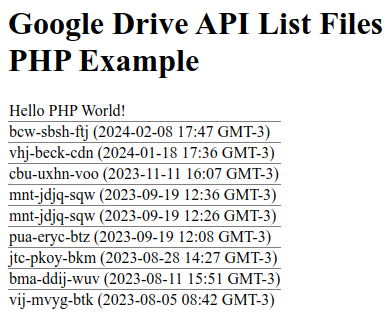Author: Manuel Lemos
Updated on: 2024-03-19
Posted on: 2024-03-19
Package: PHP OAuth Library
Developers can make Google Drive more valuable by integrating its API with other applications that need to store user files on an Internet-accessible service like Google Drive.
Please read this short tutorial to learn how to integrate PHP applications with Google Drive, using its API and the PHP OAuth client to list files stored in a Google Drive account.
In this article you will learn:
1. What is the Google Drive API
2. Why It Is a Good Idea to Use Google Drive API
3. How Can You List Files in Google Drive via OAuth
4. How Can You Download or Install the PHP OAuth Library using PHP Composer Tool

1. What is the Google Drive API
Google Drive is a well-known file storage tool.
The Google Drive API allows you to perform operations with Google Drive files and folders from external programs.
These external programs can be PHP scripts running on any computer with Internet access. These PHP scripts can send HTTP requests to the Google Drive API and perform operations to access or modify files and folders.
2. Why It Is a Good Idea to Use Google Drive API
3. How Can You List Files in Google Drive via OAuth
This is an introductory article to this topic. So here, you will only see how to implement a simple task to list the files in an account on Google Drive.
The example below shows a basic PHP script that can access the Google Drive API to access a spreadsheet in a given cell.
In future articles, I will give more details on how to set up all the details of a Google Drive API application that you can use to create your own Google Drive API applications.
After you adjust the configuration of the PHP script that you can see below, you will see a results pages like this:
Google Drive API List Files
PHP Example
| Hello PHP World! |
| bcw-sbsh-ftj (2024-02-08 17:47 GMT-3) |
| vhj-beck-cdn (2024-01-18 17:36 GMT-3) |
| cbu-uxhn-voo (2023-11-11 16:07 GMT-3) |
| mnt-jdjq-sqw (2023-09-19 12:36 GMT-3) |
| mnt-jdjq-sqw (2023-09-19 12:26 GMT-3) |
| pua-eryc-btz (2023-09-19 12:08 GMT-3) |
| jtc-pkoy-bkm (2023-08-28 14:27 GMT-3) |
| bma-ddij-wuv (2023-08-11 15:51 GMT-3) |
| vij-mvyg-btk (2023-08-05 08:42 GMT-3) |
<?php
/*
* list_files_in_google_drive.php
*
* @(#) $Id: $
*
*/
// Include the necessary class files directly or
// vendor/autoload.php if you used composer to
// install the package.
require('http.php');
require('oauth_client.php');
$client = new oauth_client_class;
$client->server = 'Google';
$client->debug = false;
$client->debug_http = true;
$client->redirect_uri = 'https://'.$_SERVER['HTTP_HOST'].
dirname(strtok($_SERVER['REQUEST_URI'],'?')).
'/list_files_in_google_drive.php';
$client->client_id = ''; $application_line = __LINE__;
$client->client_secret = '';
if(strlen($client->client_id) == 0
|| strlen($client->client_secret) == 0)
die('Please go to Google APIs console page '.
'https://console.cloud.google.com/apis/api/drive.googleapis.com/'.
' in the API access tab, create a new client ID,'.
' and in the line '.$application_line.
' set the client_id to Client ID'.
' and client_secret with Client Secret. '.
'The callback URL must be '.$client->redirect_uri.
' but make sure the domain is valid and'.
' can be resolved by a public DNS.');
/* API permissions
*/
$client->scope = 'https://www.googleapis.com/auth/drive';
if(($success = $client->Initialize()))
{
if(($success = $client->Process()))
{
if(strlen($client->authorization_error))
{
$client->error = $client->authorization_error;
$success = false;
}
elseif(strlen($client->access_token))
{
$success = $client->CallAPI(
'https://www.googleapis.com/drive/v3/files',
'GET', array(), array('FailOnAccessError'=>true),
$files_list);
}
}
$success = $client->Finalize($success);
}
if($client->exit)
exit;
if($success)
{
?>
<!DOCTYPE html>
<html>
<head>
<title>Google Drive API List Files PHP Example</title>
</head>
<body>
<h1>Google Drive API List Files<br>PHP Example</h1>
<table rules="all">
<?php
$limit = 10;
$exclude = array(
);
$list = 0;
foreach($files_list->files as $f => $file)
{
if($list >= $limit)
break;
foreach($exclude as $match)
{
if(preg_match('/'.$match.'/', $file->name))
continue 2;
}
echo '<tr><td>'.
htmlspecialchars($file->name).
'</td></tr>',"\n";
$list++;
}
?>
</table>
</body>
</html>
<?php
}
else
{
?>
<!DOCTYPE html>
<html>
<head>
<title>OAuth client error</title>
</head>
<body>
<h1>OAuth client error</h1>
<pre>Error: <?PHP
echo HtmlSpecialChars($client->error);
?></pre>
</body>
</html>
<?php
}
?>
4. How Can You Download or Install the PHP OAuth Library using PHP Composer Tool
The PHP OAuth library used in this article's example script can be installed manually by downloading the package files from the download page.
This package requires the PHP HTTP client class, which can also be installed manually after downloading the PHP HTTP client class package from its download page.
All these packages can be installed automatically from the PHP Composer tool by following the instructions to install the PHP OAuth client package to set up your project composer.json file to use these packages.
You need to be a registered user or login to post a comment
1,616,870 PHP developers registered to the PHP Classes site.
Be One of Us!
Login Immediately with your account on:
Comments:
No comments were submitted yet.


